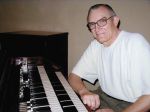Even though he would be the only one or one of a very few White faces on stage or in the building during his early years, he continued to play his music, which was a combination of jazz and R&B on an instrument few have been able to master.
Gene Ludwig, a leading figure on the Pittsburgh jazz scene for half a century and one of the select few to master the Hammond organ, died in West Penn-Forbes Regional Campus July 14, at the age of 72.
 |
|
GENE LUDWIG
|
His musical direction changed from big band to jazz/R&B after listening to Porky Chedwick on radio.
“I just fell in love with the groove and I started trying some of that on the piano,” Ludwig said. Rumor has it he decided to switch from the piano to the organ in the 1960s after visiting the Hurricane nightclub in the Hill District to hear the king of the organ, Jimmy Smith. The nightclub was a jazz mecca that included a lot of organ trios at the time. Consequently, he decided to buy a Hammond organ, first an M100 and then a C model. After a 1964 gig in Atlantic City, N.J., on which they shared a bill, Smith influenced him to buy a B-3 organ.
He was bitten by the bug before he had a chance to know what it was all about. “Around 1949, 1950, I used to hear swing organ on the air and it happened to be Bill Davis and Bill Doggett…but all I had heard was the big, full, block chords and I was into piano and (then) when I heard Jimmy (Smith) playing on the air, he was playing single lines like a piano player or like a horn and I said, ‘Oh wow!…This is amazing’ and then when I first saw him play and I heard him live, my God, it was awesome, it was really awesome,” said Ludwig.
His love of music and the instrument is why he was generally the lone White face in the clubs, because the clubs he worked were a part of the “chitlin’ circuit,” which were Black clubs that featured jazz and R&B, Black music. Those where the good old days, but later when jazz began to lose its popularity, gigs became tougher and the crowd became Whiter, but he never diverted from his music.
Though not known as a recording artist, he released numerous albums and CDs as both a sideman and leader. In 1969, he appeared on saxophonist Sonny Stitt’s “Night Letter” and released “Now is the Time” about a decade later. He signed a record deal in 1997 with Blues Leaf Records and cut several CDs for that label, the most recent with the Bill Warfield Big Band in 2007.
“Tradition, the handing down of customs, beliefs and stories from generation to generation, runs especially strong among jazz organists. They are a select crew, after all, piloting Jazz’ Spruce Goose, the technically marvelous Hammond B-3 organ, through the turbulence of time and popular taste. It’s no easy feat, of course, coordinating hands and feet, keys and pedals with mind and spirit. It’s no secret either that, when done right, the Hammond beast soars like nothing else. Its twists and turns, jives and grooves, speak, communicate and resonate with you. Academics call this ‘soul-jazz.’ Fans call it good music. Gene Ludwig calls it a career, a life’s work. Playing organ since 1958, Ludwig’s craft is an ongoing admiration of masters who came before, of traditions, of truth. Explaining it with words gets academic and dry. We’ll let Gene explain it, let him take us on the ride,” this was the best description of the man and his music by Germein Linares, managing editor of “All About Jazz.”
Ludwig left no other survivors, other than his wife Patti of nine years. Visitation was July 19 and the funeral was July 20 at Jobe Funeral Home, Monroeville. A musical tribute took place at 11 a.m. July 21 at Palmieri’s Restaurant, Plum, followed by lunch. Ludwig’s remains were cremated.
Quotes from other noted players about Ludwig and his music.
“Gene always plays the organ like it’s supposed to be played… He’s a fine player and does it the correct way.”—Lonnie Smith
“Gene’s hung in there like the rest of us have. He’s a very good player, a good-hearted guy, and the man can play.”—Jimmy McGriff
“We’ve been playing together for years and years… A nice fella and he’s a good musician.”—Jack McDuff
“As always, Gene Ludwig’s playing is as powerful as you can get…My own personal feelings about Ludwig as a major player go as far back as the early 1960s when we co-led a great organ trio including Randy Gelispie on drums. ‘On Soul Serenade,’ his playing is stronger than ever and keeps on growing.”—Pat Martin